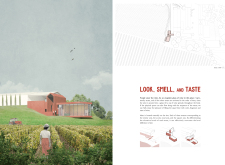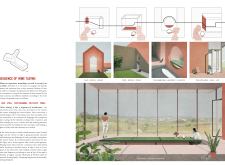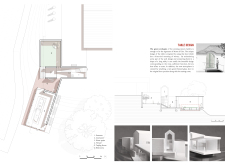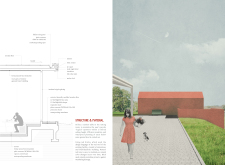5 key facts about this project
The winery features a multi-mass design, with distinct areas dedicated to wine production, tasting, and outdoor activities. This organized spatial layout enhances user interaction with both the interior and exterior spaces. The main building showcases a slanted roof that merges traditional winery aesthetics with modern architectural design, utilizing red bricks for facade construction, which echo regional materials and provide a warm atmosphere.
A glass-enclosed tasting room allows for extensive views over the vineyard, creating a connection between visitors and the landscape. This design decision promotes natural light within the space, enhancing the sensory experience of wine tasting. Adjacent outdoor spaces facilitate exploration and highlight the integration of wine with the surrounding natural elements.
Unique Design Approaches
The project distinguishes itself through its deliberate focus on sensory engagement. Each space is designed to enhance specific aspects of the wine tasting experience, forging a direct relationship between architecture and the ritual of tasting wine. The long communal table in the tasting room, inspired by an existing arch-gate structure, serves as a centerpiece that fosters conversation and interaction among visitors. This element emphasizes communal aspects of wine tasting, moving beyond individual experience to create a sense of community.
The use of materials also sets this project apart. Red bricks, glass, natural stone, and wood have been carefully selected for both their aesthetic qualities and sustainability. The materials reflect a commitment to integrate the built environment with natural surroundings, allowing the winery to blend seamlessly into the landscape while providing functional and durable spaces.
Integrated Spatial Dynamics
The project prioritizes a cohesive flow between different functional areas. The organization of the spaces allows for a natural progression from observing the vineyard to experiencing the details of wine tasting. Pathways between different areas guide visitors through the winery, aiding their journey and enhancing their engagement with the environment. The thoughtful elevation changes further contribute to the dynamic experience, providing visual variety and connection to the landscape.
For a comprehensive understanding of the architectural concepts, materials, and design outcomes, interested readers are encouraged to explore the detailed architectural plans, sections, and specific designs related to this winery project. These elements offer deeper insights into the coherent vision that shapes the spatial experience and functional requirements of the winery.


























